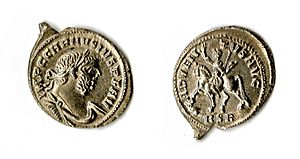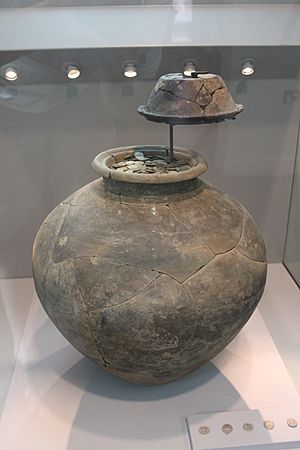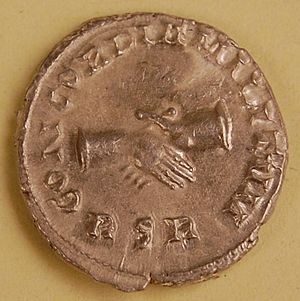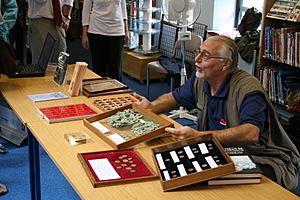Frome Hoard facts for kids
Quick facts for kids Frome Hoard |
|
|---|---|

Coins from the hoard
|
|
| Material | Silver and bronze coins |
| Size | 52,503 coins |
| Created | early 4th century |
| Period/culture | Romano-British |
| Discovered | April 2010 Near Frome, Somerset, 51°13′41″N 2°16′55″W / 51.228°N 2.282°W |
| Discovered by | Dave Crisp |
| Present location | Museum of Somerset, Taunton, England |
The Frome Hoard is a huge collection of over 52,000 Roman coins. It was discovered in April 2010 by a metal detector enthusiast named Dave Crisp. He found the coins near the town of Frome in Somerset, England.
The coins were hidden inside a large clay pot, about 45 centimeters (18 inches) wide. They date back to the years AD 253 to 305. Most of the coins are made from a mix of silver and bronze. This hoard is one of the biggest ever found in Britain. It's also special because it has the largest group of coins from Carausius. He was a Roman Emperor who ruled Britain on his own from 286 to 293. The Museum of Somerset in Taunton bought the hoard in 2011.
Contents
Finding the Treasure
How it was Found

Dave Crisp found the hoard on April 11, 2010. He was using his metal detector in a field near Frome. He had found Roman coins there before. While searching, he got a "funny signal" from his detector.
He dug down about 35 centimeters (14 inches). There, he found a small coin and the top of a pot. Dave quickly realized he had found a full coin hoard. He stopped digging right away and covered the hole. In 22 years of metal detecting, this was his most important discovery.
Digging it Up Carefully
On April 15, Dave told the experts about his find. On April 22, archaeologists visited the site. They started a careful dig from April 23 to 25.
The archaeologists dug a trench around the pot. They saw that a smaller bowl had been placed upside down on top of the main pot, like a lid. The large pot had broken while it was buried. Because the coins were so heavy, the archaeologists decided to dig them out in the field.
They removed the coins layer by layer. This helped them see if older coins were at the bottom and newer ones at the top. The coins were put into 66 labeled bags. In total, they weighed about 160 kilograms (350 pounds)! It's thought that the pot was buried first, and then the coins were poured in.
After the coins were removed, experts checked the area. They used special equipment to look for signs of an ancient settlement. However, they didn't find any.
Cleaning the Coins

On April 26, experts from the British Museum collected the coins. They took them to London. Over the next six weeks, a conservator named Pippa Pearce washed and dried all the coins. This helped to protect them from further damage. A full cleaning would have cost a lot more money.
What Was Found

The hoard contains 52,503 coins. They include 67 different types of coins. Most are made of bronze, but five are made of pure silver. The coins were made between the years 253 and 305 AD.
About 44,245 coins have been identified so far. The rest are still being cleaned. Many coins were from the central Roman Empire. Others came from the breakaway Gallic Empire. A special group of 766 coins were from the Britannic Empire of Carausius. He ruled Britain from 286 to 293 AD. The five silver coins from Carausius are very rare. They were the only silver coins made anywhere in the Roman Empire at that time.
| Reign | Date | Number of coins | Empire |
|---|---|---|---|
| Valerian & Gallienus (joint reign) | 253–260 | 46 | Central Empire |
| Gallienus (sole reign) | 260–268 | 6,091 | Central Empire |
| Salonina (wife of Gallienus) | 260–268 | 404 | Central Empire |
| Claudius II | 268–270 | 5,421 | Central Empire |
| Divus Claudius | 270–271 | 1,227 | Central Empire |
| Quintillus | 270 | 333 | Central Empire |
| Aurelian | 270–275 | 266 | Central Empire |
| Severina (wife of Aurelian) | 270–275 | 13 | Central Empire |
| Tacitus | 275–276 | 252 | Central Empire |
| Florian | 276 | 10 | Central Empire |
| Probus | 276–282 | 619 | Central Empire |
| Carus | 282–283 | 8 | Central Empire |
| Divus Carus | 283 | 5 | Central Empire |
| Magnia Urbica (wife of Carus) | 282–283 | 2 | Central Empire |
| Carinus | 282–285 | 19 | Central Empire |
| Numerian | 283–284 | 12 | Central Empire |
| Diocletian | 285–305 | 38 | Central Empire |
| Maximian | 286–305 | 22 | Central Empire |
| Postumus | 260–269 | 257 | Gallic Empire |
| Laelian | 269 | 4 | Gallic Empire |
| Marius | 269 | 35 | Gallic Empire |
| Victorinus | 269–271 | 7,494 | Gallic Empire |
| Divus Victorinus | 271 | 14 | Gallic Empire |
| Tetricus I | 271–274 | 12,416 | Gallic Empire |
| Tetricus II | 272–274 | 5,203 | Gallic Empire |
| Uncertain | 2,954 | Gallic Empire | |
| Carausius | 286–293 | 766 | British Empire |
Why Was it Buried?
Most Roman coin hoards were buried by people for safekeeping. They planned to dig them up later. However, experts think the Frome Hoard might be different. The pot was so big and fragile that it would have been hard to get back without breaking it. So, some believe it might have been a special offering to the gods.
Official Valuation and Purchase
On July 22, 2010, an official meeting was held. It was decided that the coins were "treasure". This means they officially belonged to the Crown (the government). However, under a special law, a museum can buy the treasure. The money from the sale is then shared between the finder and the landowner.
The Museum of Somerset wanted to buy the hoard. In October 2010, the hoard was valued at £320,250. A public appeal was started to raise this money. If the museum raised the money by February 1, 2011, Dave Crisp and the landowners, Geoff and Anne Sheppard, would share the reward. The Art Fund gave £40,250 to help.
Where to See the Hoard
A few coins from the hoard were shown at the British Museum in London in July and August 2010. Some were also displayed at Frome Library. The discovery was even featured on a BBC Two TV show called Digging for Britain.
In 2011, the Museum of Somerset in Taunton successfully bought the hoard. They received a grant from the National Heritage Memorial Fund. This grant also included money for the coins' conservation. The Frome Hoard went on permanent display at the Museum of Somerset when it reopened on September 29, 2011.



